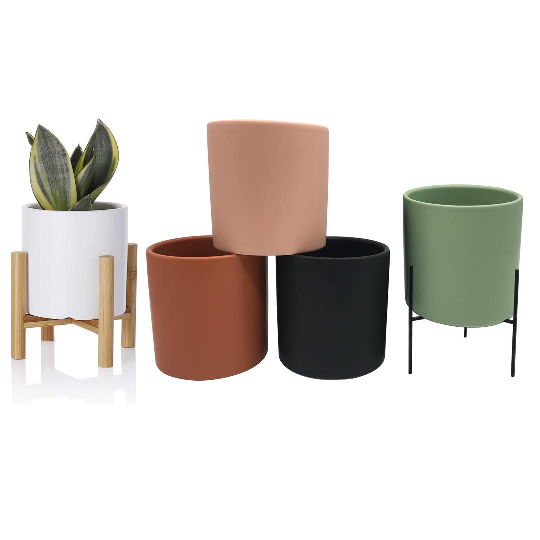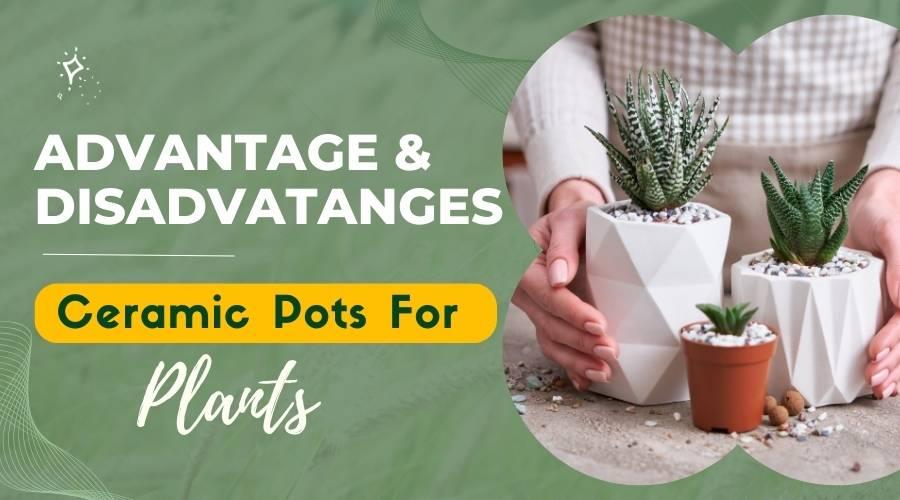Are Ceramic Pots Good for Plants? Discover the Benefits!
Time of issue: 2024-10-10 16:25:57
Are ceramic pots good for plants? Absolutely! Ceramic pots offer a blend of aesthetic appeal and functional benefits that make them an excellent choice for housing your plants.
At Global Reach Ceramic, we understand the importance of providing your plants with the right environment to thrive. Ceramic pots not only enhance the beauty of your home or office but also contribute to the health of your plants through better air circulation and moisture retention.
With our carefully crafted selection, you can trust that your plants are getting the best care while adding a touch of elegance to your space.
Are Ceramic Pots Good for Plants?

Yes, ceramic pots are excellent for plants, offering several key benefits that make them a favored choice for both indoor and outdoor gardening. Their porous nature allows air and water to pass through, which promotes healthy root growth by ensuring good air circulation and reducing the risk of root rot. This breathability also aids in regulating moisture levels within the soil, maintaining a balanced moisture environment crucial for plant health.
Additionally, ceramic pots provide effective insulation for plant roots against temperature fluctuations, which is especially beneficial in varying outdoor climates.
Beyond functionality, ceramic pots add aesthetic value with a variety of designs, colors, and finishes, enhancing the decor of any space. Their durability and stability also make them ideal for supporting top-heavy plants or those that grow large and heavy, making ceramic pots a practical and stylish choice for gardeners.
Benefits of Using Ceramic Pots for Your Plants

Ceramic pots aren't just beautiful - they're a wise choice for both novice and experienced gardeners. Here’s why using ceramic pots can make a significant difference in your plant care routine:
Promoting Healthy Root Growth
One of the standout benefits of ceramic pots is their ability to help maintain healthy root systems. Unlike plastic pots, ceramic is porous, allowing air and water to pass through the walls. This air flow is crucial for preventing root rot, a common issue in non-porous containers. For you, this means healthier plants that are more resilient to pests and diseases.
Enhancing Indoor and Outdoor Decor
Ceramic pots offer a timeless aesthetic appeal that fits well with any decor style, from rustic to modern. They come in various finishes and designs, allowing you to beautifully showcase your plants wherever you choose. Whether indoors or in your garden, these pots can elevate the look of your space, making it more inviting and vibrant.
Improved Moisture Control
Ceramic pots offer superior moisture control compared to other materials like plastic or metal. The porous nature of ceramic helps regulate the moisture levels in the soil, providing a balanced environment that can prevent both overwatering and under-watering. This is particularly beneficial for moisture-sensitive plants that require a delicate balance to thrive. With ceramic pots, you're better equipped to maintain the perfect moisture level, which can lead to healthier plants and less maintenance for you.
Eco-Friendly Choice
Choosing ceramic pots is an eco-friendly decision. Ceramic is a natural material that doesn't rely on petroleum products or result in significant chemical runoff during production. Moreover, these pots are long-lasting, reducing the need for frequent replacements and minimizing waste. By opting for ceramic pots, you are making a sustainable choice that benefits the environment while providing a safe and healthy home for your plants.
How To Choose the Right Ceramic Pots

Selecting the right ceramic pot is crucial for ensuring your plants thrive. Here’s how you can pick the best pots for your gardening needs:
Factors to Consider When Buying Ceramic Pots
When shopping for ceramic pots, consider the size and drainage needs of your plants. A pot that's too small can restrict root growth, while one that's too large may hold excessive moisture, potentially leading to root rot. Always choose a pot with drainage holes, and if it doesn’t have them, be prepared to drill some yourself to ensure excess water can escape, keeping your plants healthy.
Top Styles and Colors in 2023
This year, bold colors and minimalist designs are trending. Vibrant blues, deep greens, and earthy terracottas are popular choices that can add a pop of color to your home or garden. For a more modern look, opt for sleek, geometric shapes in neutral colors. These contemporary styles not only provide a home for your plants but also act as standalone pieces of decor.
By following these tips and choosing the right ceramic pots, you can significantly enhance the health of your plants and the aesthetics of your environment.
How to Care for Plants in Ceramic Pots
Proper care is essential when it comes to nurturing plants in ceramic pots. Here’s a detailed guide to help you ensure your plants not only survive but thrive.
Watering Tips for Ceramic Containers
Watering plants in ceramic pots requires a bit more attention than other types. Because ceramic is porous, it allows for greater airflow but also more evaporation. Always check the topsoil—if it feels dry to the touch, it’s time to water. However, be careful not to overwater; ensure your ceramic pots have adequate drainage to prevent water from pooling at the bottom, which can lead to root rot. Consider using a watering can with a long spout to control the flow and target the soil directly, avoiding the leaves.
The Best Soil Mix for Ceramic Pots
Choosing the right soil mix is crucial for ceramic pots. A well-draining potting mix, typically a blend of peat, pine bark, and either perlite or vermiculite, works best. This mix ensures that the soil doesn’t hold too much moisture, reducing the risk of fungal diseases. For added nutrition, incorporate a slow-release fertilizer into the mix before planting. This way, your plants receive consistent nutrients over time, promoting steady, healthy growth.
Why Choose Global Reach Ceramic for Your Planting Needs?
At Global Reach Ceramic, we’re not just about selling pots; we’re about delivering quality and value that enhance your gardening experience.
Our Commitment to Quality and Sustainability
Our ceramic pots are crafted from the finest materials, ensuring durability and longevity. We’re committed to sustainability, utilizing eco-friendly practices in our manufacturing processes. By choosing Global Reach Ceramic, you’re not only selecting a product that will last but also supporting environmental stewardship.
Customer Success Stories and Testimonials
Don’t just take our word for it—our customers rave about the difference our ceramic pots make. From avid gardeners who’ve seen their plants flourish to beginners delighted by their newfound green thumb, our community’s success stories are a testament to the quality we deliver. Each testimonial reflects our commitment to not just meeting but exceeding customer expectations.
Final Thought
In conclusion, the question Is ‘’Are Ceramic Pots Good for Plants? Direct answer Ceramic pots are highly beneficial for plant growth and health, offering superior air circulation, moisture regulation, and thermal insulation compared to other materials.
At Global Reach Ceramic, we provide high-quality ceramic pots that ensure your plants thrive, thanks to their porous nature that promotes root health by allowing roots to breathe and preventing issues like root rot. Our ceramic pots also come in various designs and colors, enhancing both indoor and outdoor spaces while adding a stylish touch to your decor. They are durable and practical, making them a valuable investment for any gardener. With the array of benefits they offer, ceramic pots from Global Reach Ceramic stand out as a top choice for enhancing your plant care routine.
What are your thoughts on using ceramic pots? Have you noticed a difference in the health of your plants with ceramic versus other types of containers?
RECENT POSTS
- The Benefits of Wholesale High-Quality Ceramic Products for Retailers
2025-12-17
- Can You Make an Ashtray with Air Dry Clay? Pros, Cons, and Safer Alternatives
2025-12-17
- The Impact of Ceramic Materials in Energy-Efficient Buildings: Benefits and Applications
2025-12-04
- Top 7 Ceramic Cookware Health Benefits: Why It’s a Safer Choice for Your Kitchen
2025-12-04
- How to Clean Ceramic Planters and Improve Their Lifespan?
2025-11-17
- 15 Best Ceramic Holiday Gift Ideas for 2025: Thoughtful, Elegant & Heartfelt
2025-11-17
- Stoneware vs Porcelain vs Earthenware: Quick Decision Guide
2025-10-09
- Are Ceramic Glazes Food Safe? The Truth Behind the Shine
2025-10-09










